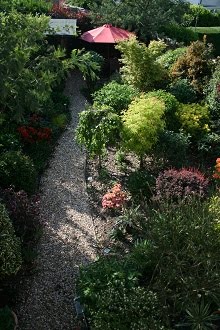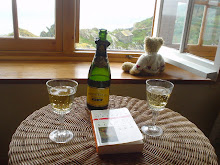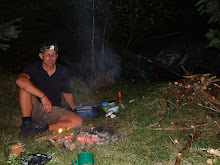Friday arrived, and we were both worn out and stressed. We only had three places to work at, and these were all nice and peaceful at least, and near Sandbanks. It was a gloriously sunny day, and so after finishing work we went home for a quick change of clothes and a hose down to remove all of the sweat and dirt, and headed back to Sandbanks and across the ferry to Shell Bay and Studland.
There are four miles of beach over there, the whole area from the open sea to the harbour being a protected nature reserve and site of specific scientific interest, and all owned by the National Trust for safe keeping.
We were going for another long walk, paddle and beachcomb, something that we have both done since we first met, many, many, many times over. At this time each year, for a period of perhaps two to three weeks, tides are such that vast amounts of seaweed are washed up on to the beach. The smell from the two feet thick rotting mass can be overwhelming, and given that the particular areas that this happens are also the main tourist parts of the beach for family gathering, people can get a little annoyed that their beach holiday is so disrupted. Most people don't realise that this annual build up is vital to the continuation of the beach and protective sand dunes, because, as the beach slowly erodes away throughout the year, the seaweed then mixes with new sand, forming a stronger base for new beach etc etc...
Once, and only once, did the powers that be outside the National Trust insist that because of the complaints, and the threat of lost tourism, that the seaweed be completely cleaned away. Unfortunately, they learned a hard lesson, as the beach and dunes were almost washed away that winter, and huge regeneration of the dunes had to commence. Holiday makers must now just cope, and they seem to do this well.
The dunes, well, they are saved for the future.
What do we beachcomb for? As well as anything that is colourful or shines, we have always searched for these little critters, and compete fiercely to see who can find the first, and then the most. Cowries, and these are very small ones, are usually the things of long, cold and wet winter walks along the beach, but I suppose climate and ocean changes have affected most things, and we can find them throughout the year now.
But, I here you all say 'What has this to do with flora?'
Well, given that it is a seaweedy time of year, all manner of aquatic plant life can be found along the shore. Kelp by the bucket load.
I'm not a seaweed expert, I just thought this was beautiful....and kind of creepy!
The occasional cockle. These are delicious when cooked, but generally they are to be found in abundance in the inner harbour at low tide.
The colour of some seaweed is amazing.
And after a long hot day, the water was lovely and cool on our feet! We walked way past the headland in the background.
Some more kelp....Looks like something Sigourney Weaver may have hunted down in Alien doesn't it?
More Kelp, and such diverse shapes and textures to cope with it's harsh environment.
Of course, Studland is also famous for it's naturist beach, which one has to walk through as it's in the middle section of this particular piece of coastline. It's amusing to see the looks on some peoples faces as the encounter for the first time, scores of naked men and women walking past them on the waters edge. It really doesn't bother either of us, as we are all pretty much the same when not suited and booted. Today was very quiet indeed, with only this lady taking her dogs for a walk.
We came across these young Slipper Limpets, gathered together rather intriguingly on a Razor Shell. When I was young, I would hook the snail out with my pocket knife and use it for bait when fishing.
lol......and more Kelp. I love taking pictures of this stuff as you can tell!
All in all a wonderful few hours spent, before having a well deserved hot chocolate at the Knoll Beach cafe.
And not a bad little haul of treasure!
Take care all of you.






































































Hello Gary:
ReplyDeleteBeachcombing, paddling and generally enjoying the seaside is such a wonderful way of spending time. Your post today reminds us so much of visiting Studland and Shell Bay many, many years ago. For years too an old coastguard cottage at Swanage was a holiday home throughout the 1950s. But that is rather going back in time!
As for the seaweed, we actually really love the smell and, of course, as you say, it does serve an environmental purpose.
So many treasure on a beach walk, I do the same thing. Great pictures! thanks !
ReplyDeleteWhat interesting shapes of the sea weeds. Love the little treasures. The life cycles of the beach, unknown to me; but certainly make sense. Everything needs to rejuvenate. People included. Sounds like you found a nice way to do that. Enjoy your weekend!
ReplyDeleteI like your shots of all the seawood and kelp. What a beautiful place to help relax the mind. Every weekend I try to get out and do something out in the wild to help center me. And it's great that you have someone to share the experience with. Our work schedules don't always coincide.
ReplyDeleteI like the seaweed story. Glad that all was saved in the end. People can make some bad decisions at times when it comes to "enhancing" an area by getting rid of vital components in an ecosystem. So the happy ending is nice to hear. Enjoy the rest of your weekend. Chris
I LOVE beachcombing so it is great to wander along the sand with you both and look at the treasures. What a fabulous coastline it is.
ReplyDelete